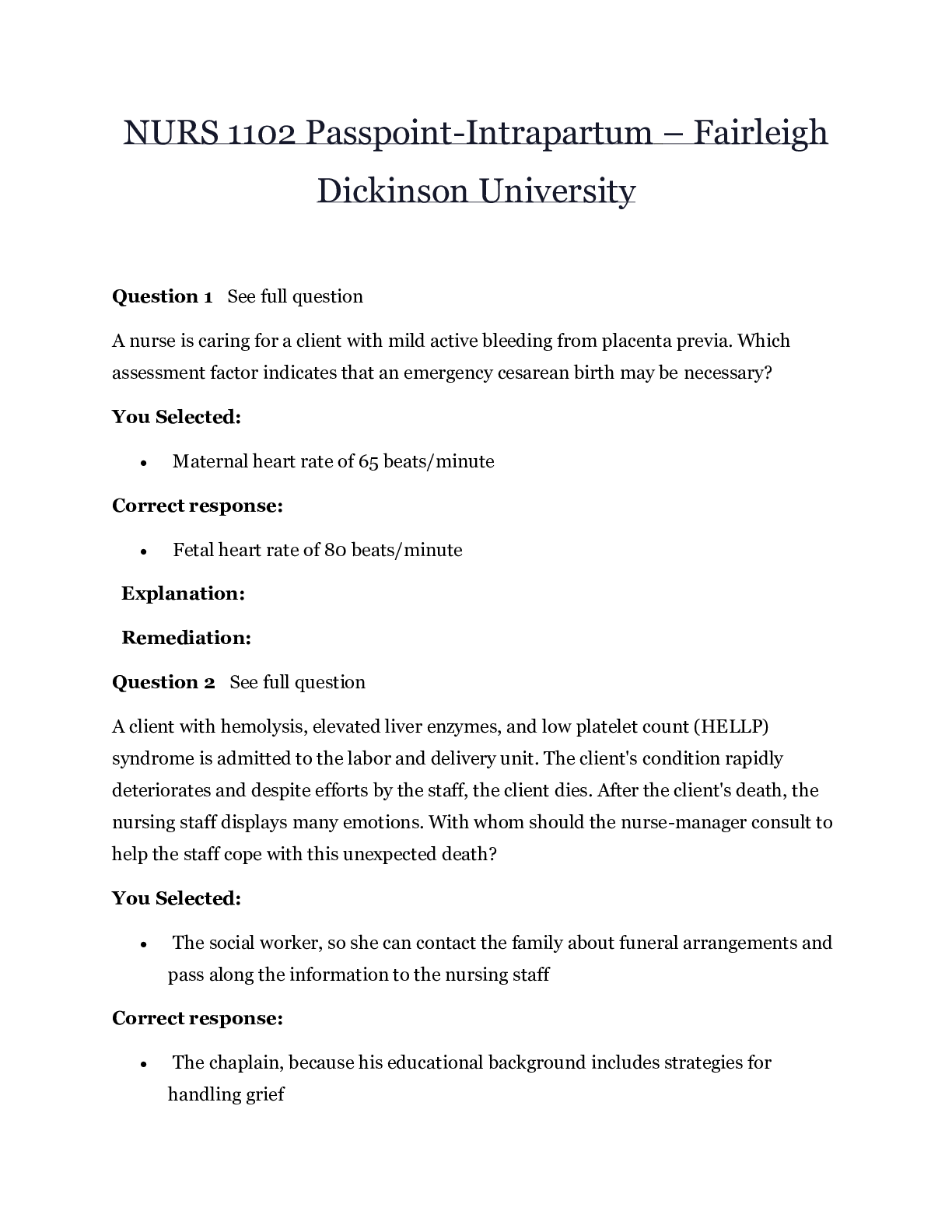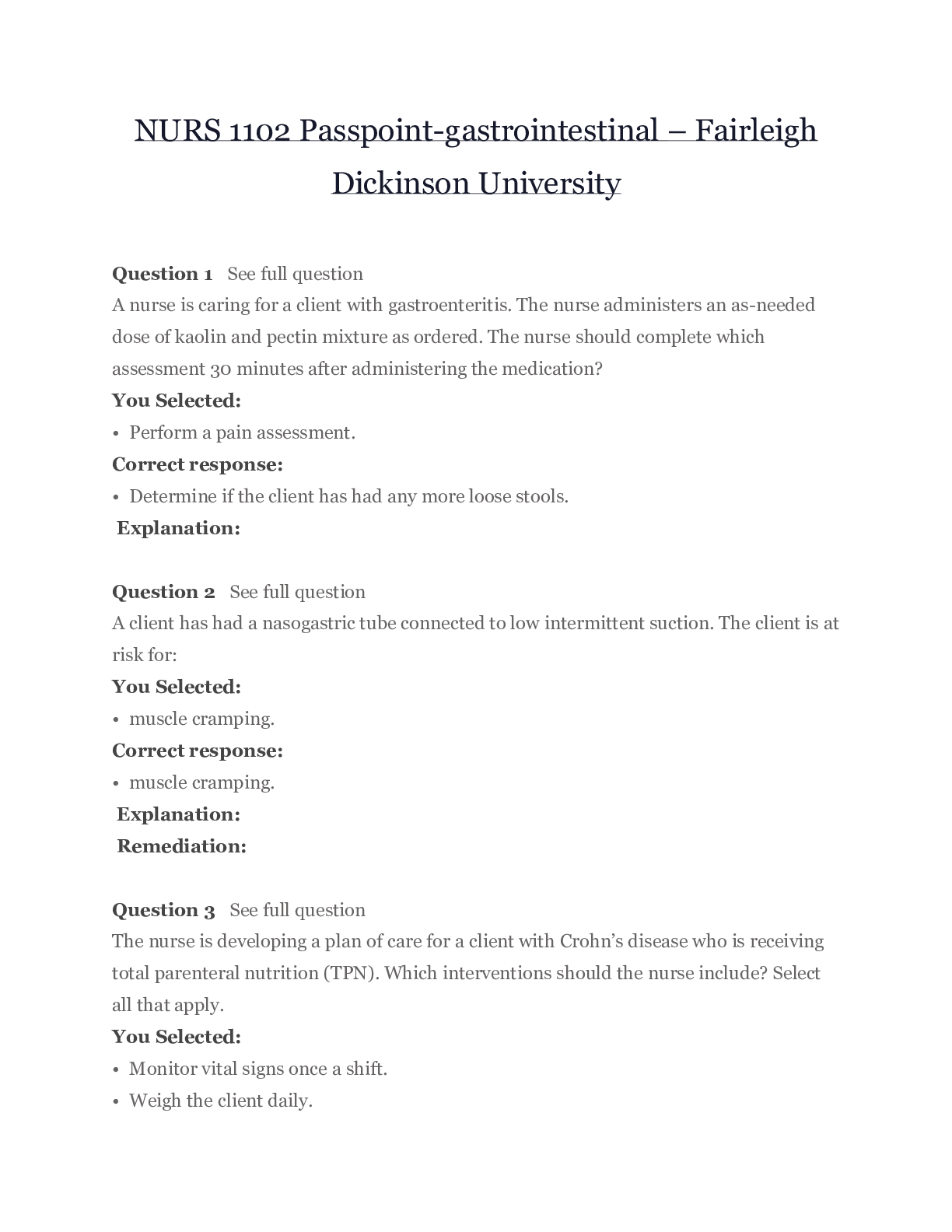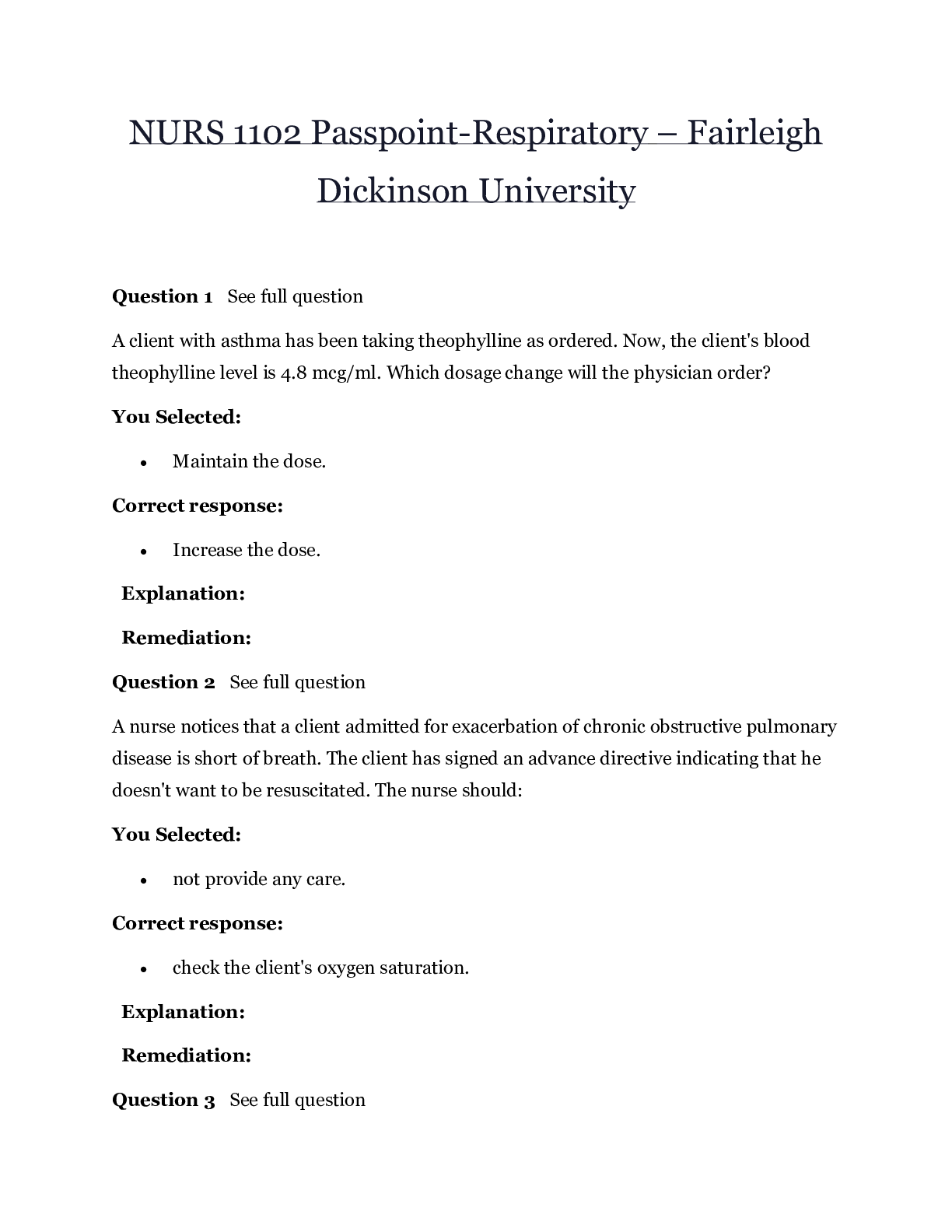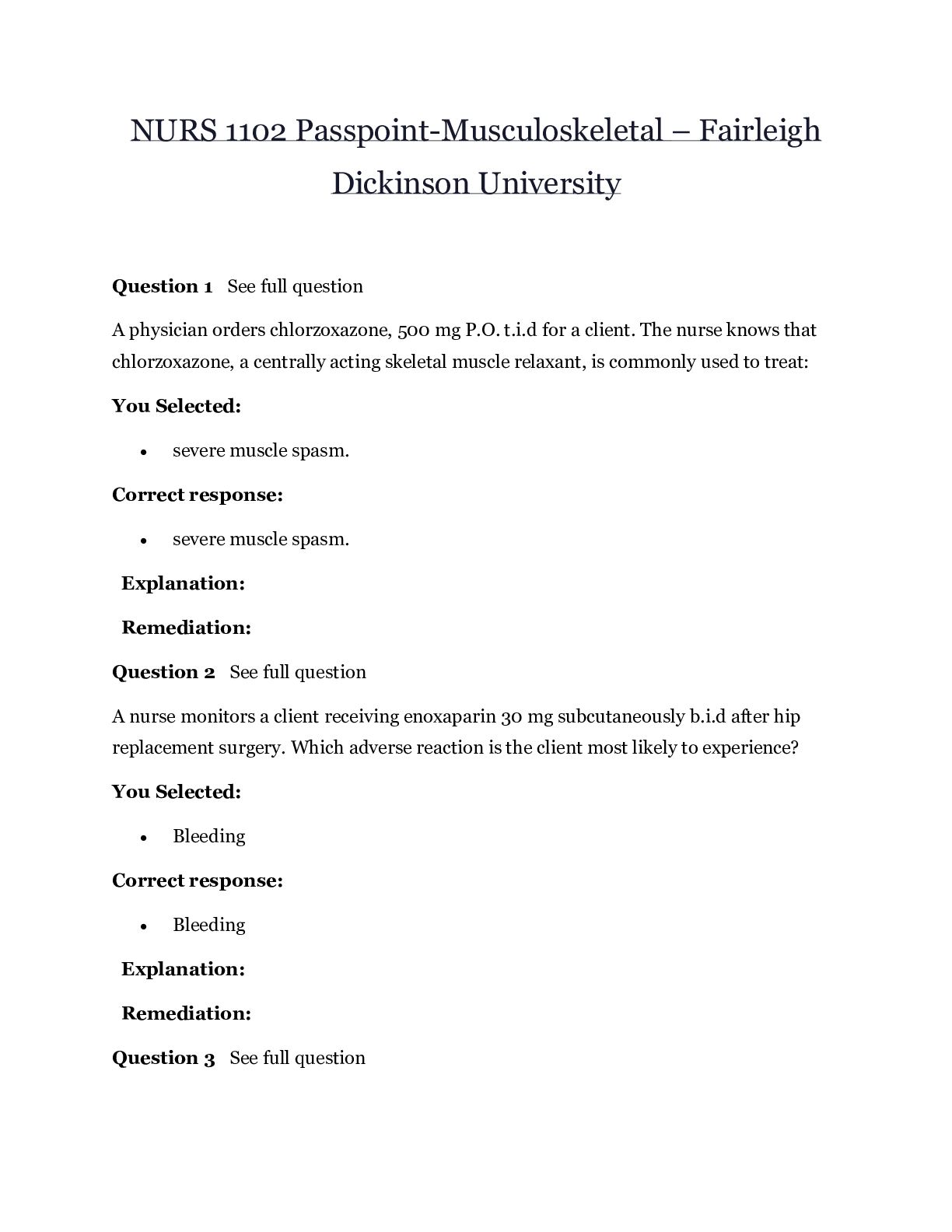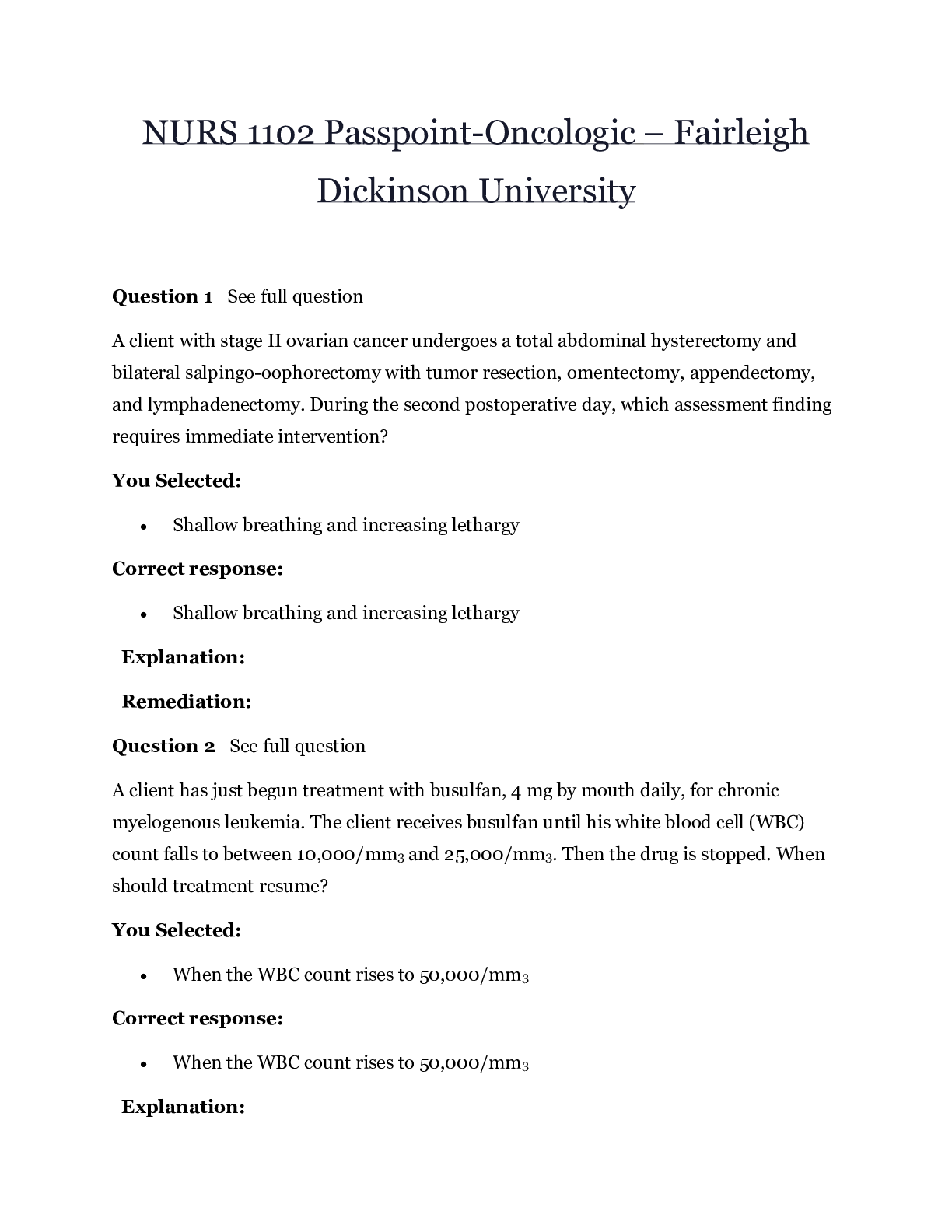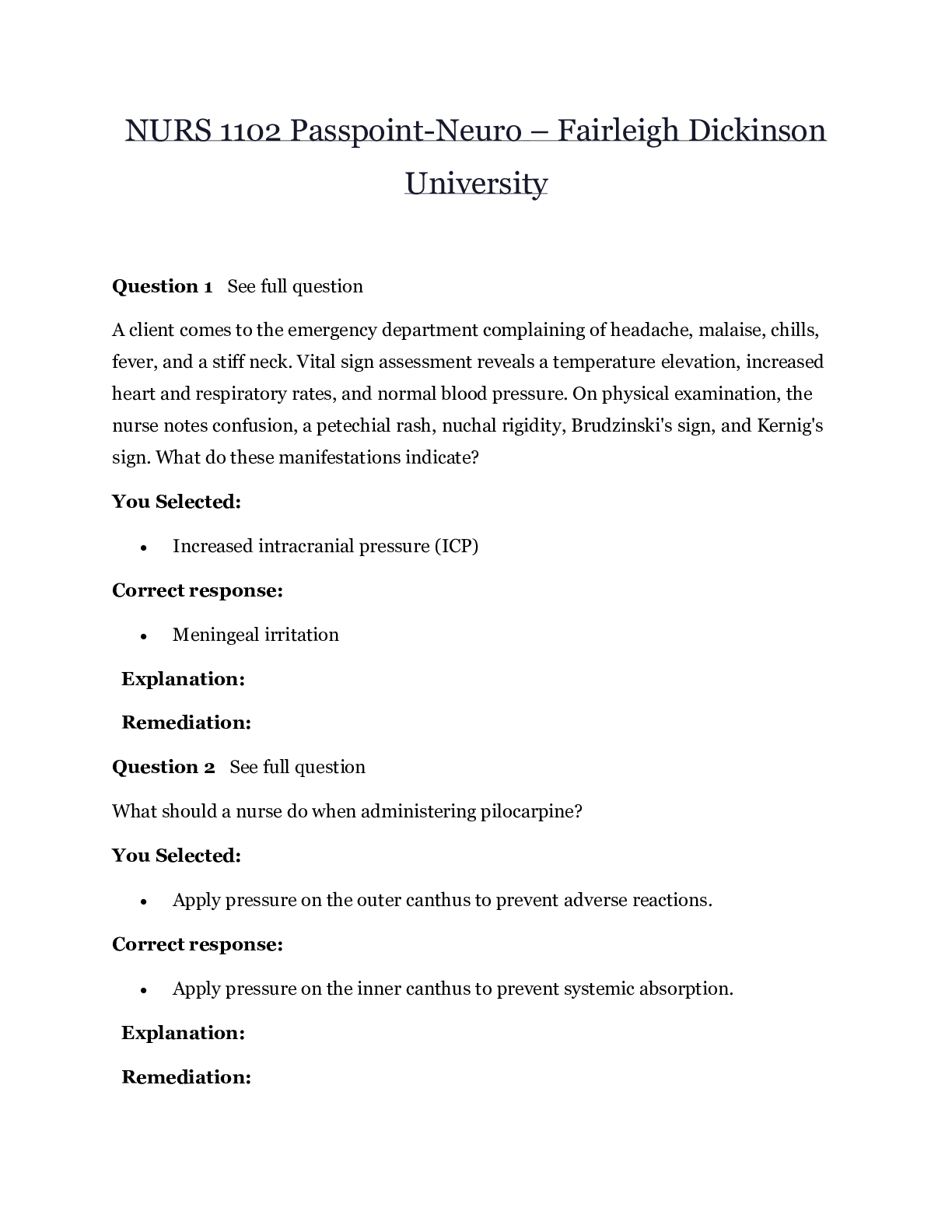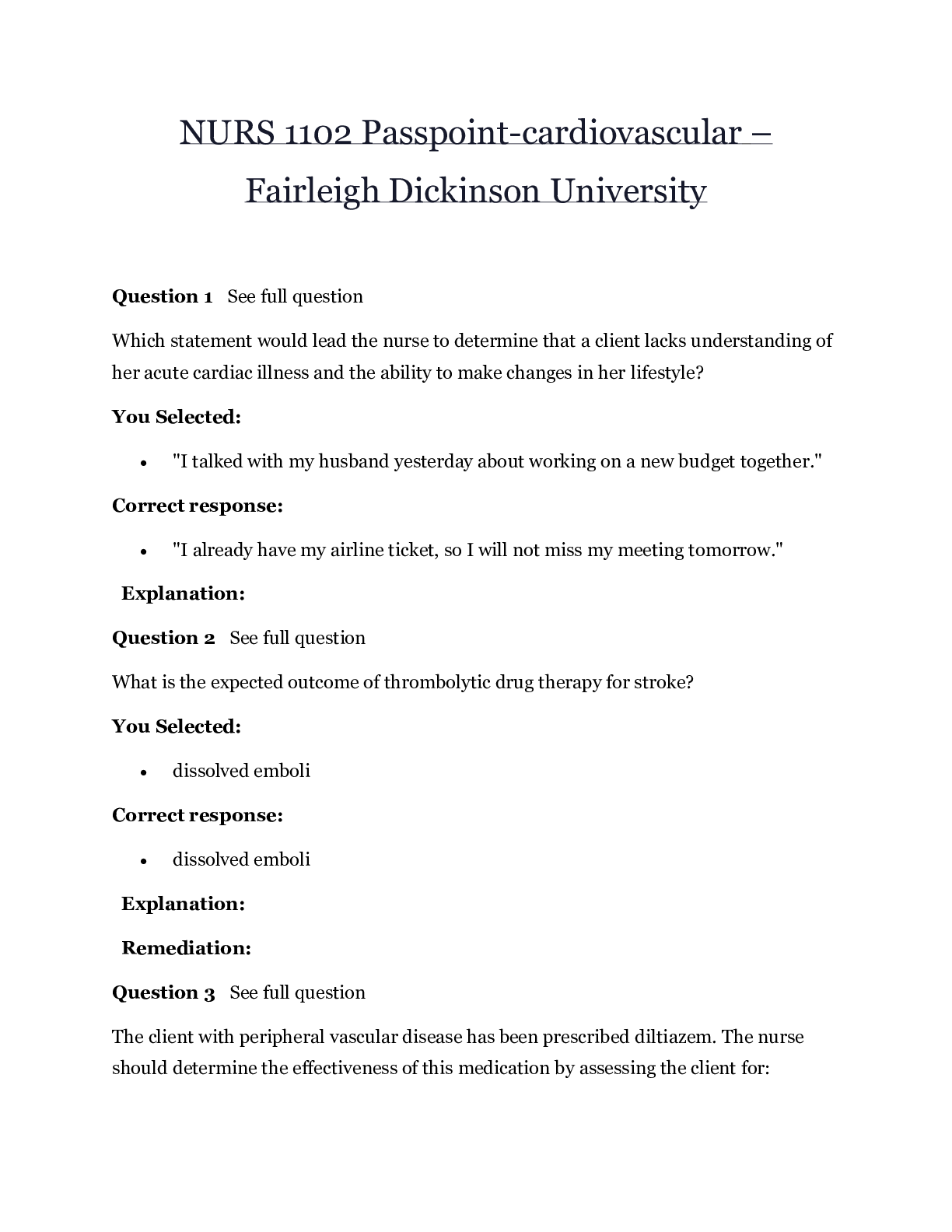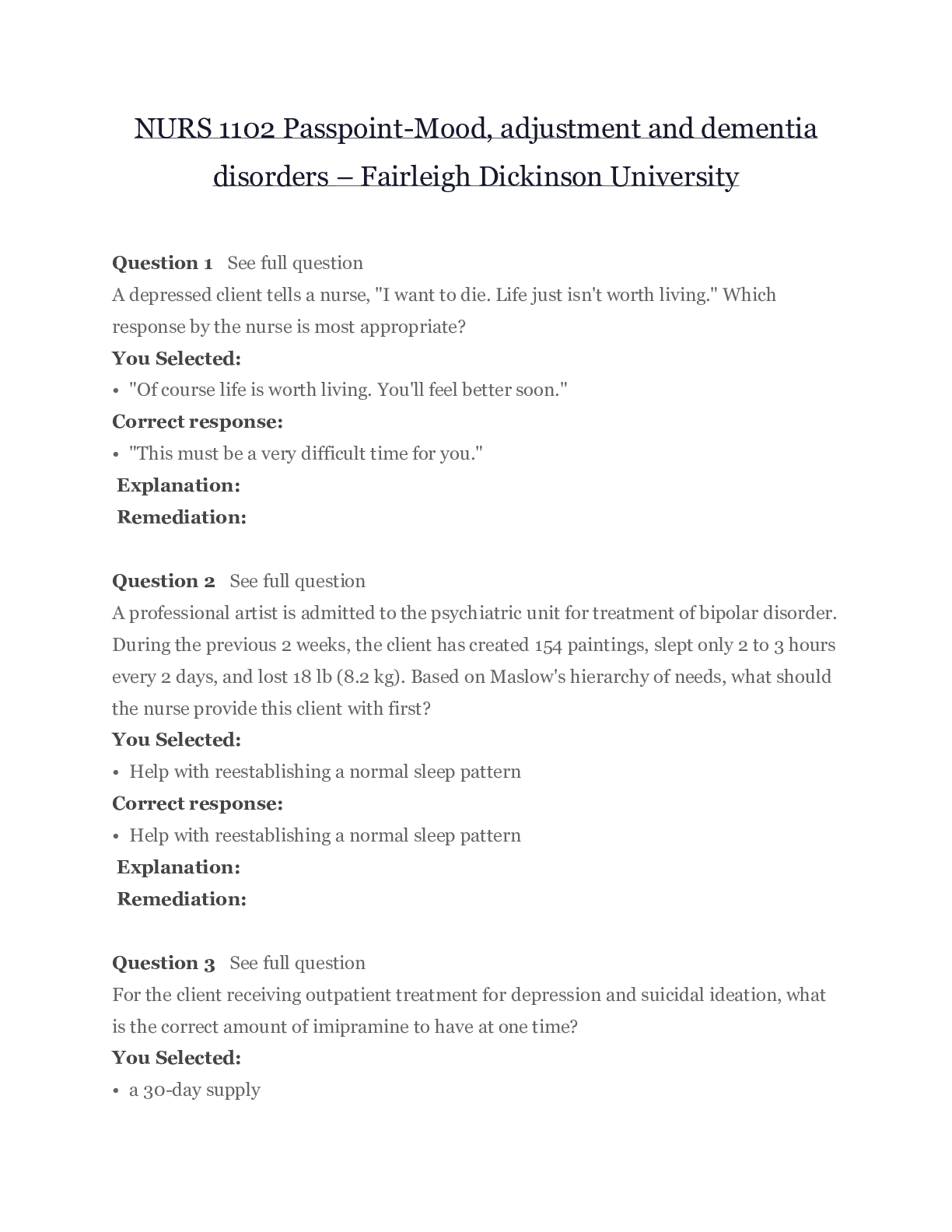*NURSING > EXAM > NURS 1102 Passpoint-Antepartum – Fairleigh Dickinson University | NURS1102 Passpoint-Antepartum (All)
NURS 1102 Passpoint-Antepartum – Fairleigh Dickinson University | NURS1102 Passpoint-Antepartum
Document Content and Description Below
NURS 1102 Passpoint-Antepartum – Fairleigh Dickinson University Question 1 See full question A nurse is developing a teaching plan for a primigravid client who's 2 months pregnant. The nur... se should tell the client that she can expect to feel the fetus move at which time? You Selected: • Between 18 and 20 weeks' gestation Correct response: • Between 18 and 20 weeks' gestation Explanation: Remediation: Question 2 See full question A client is 2 months pregnant. Which factor should the nurse anticipate as most likely to affect her psychosocial transition during pregnancy? You Selected: • The month of her due date Correct response: • Support from her partner Explanation: Remediation: Question 3 See full question A client in the first trimester of pregnancy comes to the facility for a routine prenatal visit. She tells the nurse she doesn't know whether she's ready to have a baby, even though this was a planned pregnancy. Which response should the nurse offer? You Selected: • "You're feeling ambivalent, which is normal during the first trimester." Correct response: • "You're feeling ambivalent, which is normal during the first trimester." Explanation: Remediation: Question 4 See full question A client, 30 weeks pregnant, is scheduled for a biophysical profile (BPP) to evaluate the health of her fetus. Her BPP score is 8. What does this score indicate? You Selected: • The fetus isn't in distress at this time. Correct response: • The fetus isn't in distress at this time. Explanation: Remediation: Question 5 See full question During a nonstress test (NST), a nurse notes three fetal heart rate (FHR) increases of 20 beats/minute, each lasting 20 seconds. These increases occur only with fetal movement. What does this finding suggest? You Selected: • The fetus is not in distress at this time. Correct response: • The fetus is not in distress at this time. Explanation: Remediation: Question 6 See full question A client is admitted to the facility with a suspected ectopic pregnancy. When reviewing the client's health history for risk factors for this abnormal condition, the nurse expects to find: You Selected: • a history of pelvic inflammatory disease. Correct response: • a history of pelvic inflammatory disease. Explanation: Remediation: Question 7 See full question A nurse uses Nitrazine paper to determine whether a pregnant client's membranes have ruptured. If the membranes have ruptured, the paper will turn which color? You Selected: • Blue Correct response: • Blue Explanation: Question 8 See full question At 32 weeks' gestation, a client is admitted to the facility with a diagnosis of gestational hypertension. Based on this diagnosis, the nurse expects the assessment to reveal: You Selected: • 3+ edema in the lower extremities. Correct response: • 3+ edema in the lower extremities. Explanation: Remediation: Question 9 See full question A nurse is reviewing a client's prenatal history. Which finding indicates a genetic risk factor? You Selected: • The client was exposed to rubella at 36 weeks' gestation. Correct response: • The client has a child with cystic fibrosis. Explanation: Remediation: Question 10 See full question A client who's 2 months pregnant complains of urinary frequency and says she gets up several times at night to go to the bathroom. She denies other urinary symptoms. How should the nurse intervene? You Selected: • Explain that urinary frequency is expected during the first trimester. Correct response: • Explain that urinary frequency is expected during the first trimester. Explanation: Remediation: Question 11 See full question A client, 38 weeks pregnant, arrives in the emergency department complaining of contractions. To help confirm that she's in true labor, the nurse should assess for: You Selected: • changes in cervical effacement and dilation after 1 to 2 hours. Correct response: • changes in cervical effacement and dilation after 1 to 2 hours. Explanation: Remediation: Question 12 See full question During a routine prenatal visit, a pregnant client reports constipation, and the nurse teaches her how to relieve it. Which statement indicates the client's understanding of the nurse's instructions? You Selected: • "I'll limit fluid intake to four 8-oz (240 mL) glasses." Correct response: • "I'll increase my intake of unrefined grains." Explanation: Remediation: Question 13 See full question A pregnant client arrives in the emergency department and states, "My baby is coming." The nurse sees a portion of the umbilical cord protruding from the vagina. Why should the nurse apply manual pressure to the baby's head? You Selected: • To slow the delivery process Correct response: • To relieve pressure on the umbilical cord Explanation: Remediation: Question 14 See full question A nurse is assessing a pregnant woman in the clinic. In the course of the assessment, the nurse learns that this woman smokes one pack of cigarettes per day. The first step the nurse should take to help the woman stop smoking is to: You Selected: • assess the client's readiness to stop. Correct response: • assess the client's readiness to stop. Explanation: Remediation: Question 15 See full question A nurse is caring for a 16-year-old pregnant adolescent. The client is taking an iron supplement. What should this client drink to increase the absorption of iron? You Selected: • A glass of orange juice. Correct response: • A glass of orange juice. Explanation: Remediation: Question 16 See full question A client and her spouse, both 25 years old, are having trouble conceiving. Infertility in this couple is defined as: You Selected: • the inability to conceive after 1 year of unprotected attempts. Correct response: • the inability to conceive after 1 year of unprotected attempts. Explanation: Question 17 See full question An obstetric ultrasound reveals that the client's fetus has spina bifida. The mother is concerned about raising a child with a congenital abnormality and she starts to cry. Which response by the nurse is best? You Selected: • Sit at her bedside and allow the client to express her feelings. Correct response: • Sit at her bedside and allow the client to express her feelings. Explanation: Remediation: Question 18 See full question A client who is 18 weeks pregnant is losing weight. She tells a nurse that she's out of work and, after paying bills, has no money to buy healthy food. The nurse should offer the client information about: You Selected: • Women, Infants, and Children (WIC). Correct response: • Women, Infants, and Children (WIC). Explanation: Remediation: Question 19 See full question Which instruction should a nurse include in an injury-prevention plan for a pregnant client? You Selected: • "Take rest periods during the day." Correct response: • "Take rest periods during the day." Explanation: Remediation: Question 20 See full question During routine prenatal screening, a nurse tells a client that her blood sample will be used for alpha fetoprotein (AFP) testing. Which statement best describes what AFP testing indicates? You Selected: • "This test will screen for spina bifida, Down syndrome, or other genetic defects." Correct response: • "This test will screen for spina bifida, Down syndrome, or other genetic defects." Explanation: Remediation: Question 21 See full question For the client who is receiving intravenous magnesium sulfate for severe preeclampsia, which assessment findings would alert the nurse to suspect hypermagnesemia? You Selected: • decreased deep tendon reflexes Correct response: • decreased deep tendon reflexes Explanation: Remediation: Question 22 See full question When assessing a 34-year-old multigravid client at 34 weeks' gestation experiencing moderate vaginal bleeding, which symptom would most likely alert the nurse that placenta previa is present? You Selected: • painless vaginal bleeding Correct response: • painless vaginal bleeding Explanation: Remediation: Question 23 See full question When developing the collaborative plan of care with the health care provider (HCP) for a multigravid client at 10 weeks' gestation with a history of cardiac disease who was being treated with digitalis therapy before this pregnancy, the nurse should instruct the client about which modifications regarding the client's drug therapy regimen? You Selected: • switching to a different medication Correct response: • continuation of the same dosage Explanation: Remediation: Question 24 See full question A multigravid client is admitted at 16 weeks' gestation with a diagnosis of hyperemesis gravidarum. The nurse should explain to the client that hyperemesis gravidarum is thought to be related to high levels of which hormone? You Selected: • progesterone Correct response: • estrogen Explanation: Remediation: Question 25 See full question Using Nägele's rule for a client whose last normal menstrual period began on May 10, the nurse determines that the client's estimated date of childbirth is what date? You Selected: • February 17 Correct response: • February 17 Explanation: Remediation: Question 26 See full question A 20-year-old married client with a positive pregnancy test states, “Is it really true? I can not believe I am going to have a baby!” Which response by the nurse would be most appropriate at this time? You Selected: • "Would you like some booklets on the pregnancy experience?" Correct response: • "Yes it is true. How does that make you feel?" Explanation: Remediation: Question 27 See full question A primigravid client asks the nurse if she can continue to have a glass of wine with dinner during her pregnancy. Which statement would be the nurse's best response? You Selected: • "You should abstain from drinking alcoholic beverages." Correct response: • "You should abstain from drinking alcoholic beverages." Explanation: Remediation: Question 28 See full question A 34-year-old multiparous client at 16 weeks' gestation who received regular prenatal care for all of her previous pregnancies tells the nurse that she has already felt the baby move. How does the nurse interpret this finding? You Selected: • normal because multiparous clients can experience quickening between 14 and 20 weeks' gestation Correct response: • normal because multiparous clients can experience quickening between 14 and 20 weeks' gestation Explanation: Remediation: Question 29 See full question When performing Leopold's maneuvers, which action would the nurse ask the client to perform to ensure optimal comfort and accuracy? You Selected: • empty her bladder Correct response: • empty her bladder Explanation: Remediation: Question 30 See full question A 36-year-old primigravid client at 22 weeks' gestation without any complications to date is being seen in the clinic for a routine visit. The nurse should assess the client's fundal height to: You Selected: • estimate the fetal growth. Correct response: • estimate the fetal growth. Explanation: Remediation: - - - - - - - - - - - - - - - - - - - - - - - - - - - - - - - - - - - - - Question 7 See full question A pregnant mother who has brought her toddler to the clinic for a check-up asks the nurse how she can keep her next baby from becoming obese. The mother plans to bottle-feed her next child. Which information should the nurse include in the teaching plan to help the mother avoid overnourishing her infant? You Selected: • establishing a regular feeding schedule Correct response: • recognizing clues indicating that a baby is full Explanation: Remediation: Question 8 See full question A primigravid client who was successfully treated for preterm labor at 30 weeks' gestation had a history of mild hyperthyroidism before becoming pregnant. What instructions should the nurse include in the plan of care? You Selected: • Continue taking low-dose oral propylthiouracil as ordered. Correct response: • Continue taking low-dose oral propylthiouracil as ordered. Explanation: Remediation: Question 9 See full question The health care provider (HCP) prescribes a maternal blood test for alpha fetoprotein for a nulligravid client at 16 weeks’ gestation. When developing the teaching plan, the nurse bases the explanations on the understanding that this test is used to detect which condition? You Selected: • neural tube defects Correct response: • neural tube defects Explanation: Remediation: Question 10 See full question Which of the following ethical principles supports expectant mothers when conflicts between maternal and fetal rights arise during childbirth? You Selected: • Nonmaleficence Correct response: • Autonomy Question 4 See full question A 38-year-old client at about 14 weeks' gestation is admitted to the hospital with a diagnosis of complete hydatidiform mole. Soon after admission, the nurse would assess the client for signs and symptoms of which signs and symptoms? You Selected: • pregnancy-induced hypertension Correct response: • pregnancy-induced hypertension Explanation: Remediation: Question 5 See full question Examination of a primigravid client having increased vaginal secretions since becoming pregnant reveals clear, highly acidic vaginal secretions. The client denies any perineal itching or burning. The nurse interprets these findings as a response related to which factor? You Selected: • control of the growth of pathologic bacteria Correct response: • control of the growth of pathologic bacteria Explanation: Remediation: Question 6 See full question A pregnant woman at 22 weeks’ gestation is diagnosed with gonorrhea. The health care provider (HCP) prescribes doxycycline. What should the nurse do first? You Selected: • Discuss with the HCP the need to change the prescription. Correct response: • Discuss with the HCP the need to change the prescription. Question 1 See full question The topic of physiologic changes that occur during pregnancy is to be included in a parenting class for primigravid clients who are in their first half of pregnancy. Which topic would be important for the nurse to include in the teaching plan? You Selected: • increased risk for urinary tract infections Correct response: • increased risk for urinary tract infections Explanation: Remediation: Question 2 See full question A nurse is caring for a primigravida client. At 20 weeks of gestation, identify the location where the nurse anticipates the uterine fundus. You Selected: • Your selection and the correct area, market by the green box. Explanation: Remediation: Question 3 See full question A client presents to the OB triage unit with no prenatal care and painless bright red vaginal bleeding. Which interventions are most indicated? You Selected: • applying an external fetal monitor and performing a sterile vaginal examination Correct response: • applying an external fetal monitor and completing a physical assessment Explanation: Remediation: Question 1 See full question In which maternal locations would the nurse place the ultrasound transducer of the external electronic fetal heart rate monitor if a fetus at 34 weeks' gestation is in the left occipitoanterior (LOA) position? You Selected: • below the umbilicus on the left side Correct response: • below the umbilicus on the left side Explanation: Remediation: Question 2 See full question A 19-year-old primigravid client is being discharged home after hospitalization for hyperemesis gravidarum and is being referred to home health care. The nurse should develop a discharge plan that includes which interventions? Select all that apply. You Selected: • Discuss plan of care and discharge instructions with client. • Coordinate follow-up appointment with provider in 6 weeks. Correct response: • Refer client to a nutritionist for the following day. • Ensure that the client has a prescription for an antiemetic. • Encourage return to normal routine when client feels ready. • Discuss plan of care and discharge instructions with client. Explanation: Remediation: Question 3 See full question A 16-year-old primigravida at 36 weeks' gestation who has had no prenatal care experienced a seizure at work and is being transported to the hospital by ambulance. What should the nurse do upon the client’s arrival? You Selected: • Admit the client to a quiet, darkened room. Correct response: • Admit the client to a quiet, darkened room. Explanation: Remediation: Question 4 See full question A primigravid client at 26 weeks’ gestation visits the clinic and tells the nurse that her lower back aches when she arrives home from work. The nurse should suggest that the client perform which exercise? You Selected: • shoulder circling Correct response: • tailor sitting Explanation: Remediation: Question 5 See full question A woman’s breasts undergo anatomic and physiologic changes during pregnancy and lactation. Which of the following is true? You Selected: • The alveolar cells being to secrete colostrum. Correct response: • The alveolar cells being to secrete colostrum. Explanation: Remediation: Question 4 See full question A woman’s breasts undergo anatomic and physiologic changes during pregnancy and lactation. Which of the following is true? You Selected: • Colostrum is produced during the first half of pregnancy. Correct response: • The alveolar cells being to secrete colostrum. Explanation: Remediation: Question 5 See full question A nurse is preparing to teach a client about fetal growth and development during the first 3 months of pregnancy. The nurse is assembling teaching aids by milestones. In ascending order, (month 1, month 2, month 3, and months 4 to 9), how would the nurse arrange the aids? All options must be used. You Selected: • The embryo has a definite form; the head, trunk, and tiny buds for arms and legs develop; and the cardiovascular system begins to function. • The eyes, ears, nose, lips, tongue, and tooth buds develop; the umbilical cord has a definite form; and the external genitalia are present. • Internal and external fetal growth continues at a rapid rate, and the fetus stores the fats and minerals it needs to live outside the womb. • Teeth and bones begin to appear, the kidneys start to function and, at the end of the month, gender is distinguishable. Correct response: • The embryo has a definite form; the head, trunk, and tiny buds for arms and legs develop; and the cardiovascular system begins to function. • The eyes, ears, nose, lips, tongue, and tooth buds develop; the umbilical cord has a definite form; and the external genitalia are present. • Teeth and bones begin to appear, the kidneys start to function and, at the end of the month, gender is distinguishable. • Internal and external fetal growth continues at a rapid rate, and the fetus stores the fats and minerals it needs to live outside the womb. Explanation: Question 1 See full question Which condition poses the greatest risk to a 32-year-old client who is 15 weeks pregnant and has a history of hypertension? You Selected: • Preterm labor Correct response: • Abruptio placentae Explanation: Remediation: Question 2 See full question During routine preconception counseling, a client asks how early a pregnancy can be diagnosed. What is the nurse's best response? You Selected: • "2 to 3 weeks after fertilization." Correct response: • "8 days after conception." Explanation: Remediation: Question 3 See full question The nurse conducts the health assessment of a client who is a primigravida in the prenatal clinic. Which presumptive signs of pregnancy should the nurse expect to assess? You Selected: • Braxton Hicks contractions and Hegar's sign Correct response: • Amenorrhea and quickening Explanation: Remediation: Question 4 See full question An antenatal client is discussing her anemia with the nurse in the prenatal clinic. After a discussion about sources of iron to be incorporated into her daily meals, the nurse knows the client needs further instruction when she responds with which statement? You Selected: • "Drinking coffee, tea, and sodas decrease the absorption of iron." Correct response: • "I can meet two goals when I drink milk: lots of iron and meeting my calcium needs at the same time." Explanation: Remediation: Question 5 See full question A primigravid client at 35 weeks’ gestation is scheduled for a biophysical profile. After instructing the client about the test, which client statement about what the test measures indicates effective teaching? You Selected: • amniotic fluid volume Correct response: • amniotic fluid volume Explanation: Remediation: Question 6 See full question Which action should the nurse take first when admitting a multigravid client at 36 weeks' gestation with a probable diagnosis of abruptio placentae? You Selected: • Prepare the client for an ultrasound scan. Correct response: • Insert a large-gauge intravenous catheter. Explanation: Remediation: Question 7 See full question Following an eclamptic seizure, the nurse should assess the client for which complication? You Selected: • polyuria Correct response: • uterine contractions Explanation: Remediation: Question 8 See full question A client at 36 weeks’ gestation is scheduled for a routine ultrasound prior to an amniocentesis. After teaching the client about the purpose of the ultrasound, which client statement would indicate to the nurse that the client needs further instruction? You Selected: • “The ultrasound will help to locate the placenta." Correct response: • “The ultrasound identifies blood flow through the umbilical cord." Explanation: Remediation: Question 9 See full question Which of the following situations does the nurse recognize as having the greatest risk for the fetus? You Selected: • A breech lie Correct response: • A fundal height of 27 cm at 32 weeks gestation Explanation: Remediation: Question 10 See full question The nurse is caring for a client who is 12 weeks pregnant and speaks Spanish only. Which interventions should the nurse include in the plan of care at the client’s initial visit? Select all that apply. You Selected: • Review dietary intake and discuss nutrition. • Arrange for an interpreter for her appointments. • Provide brochures in the client’s native language. Correct response: • Provide brochures in the client’s native language. • Arrange for an interpreter for her appointments. • Review dietary intake and discuss nutrition. [Show More]
Last updated: 1 year ago
Preview 1 out of 185 pages

Buy this document to get the full access instantly
Instant Download Access after purchase
Add to cartInstant download
We Accept:

Reviews( 0 )
$16.50
Document information
Connected school, study & course
About the document
Uploaded On
Aug 15, 2020
Number of pages
185
Written in
Additional information
This document has been written for:
Uploaded
Aug 15, 2020
Downloads
0
Views
56













